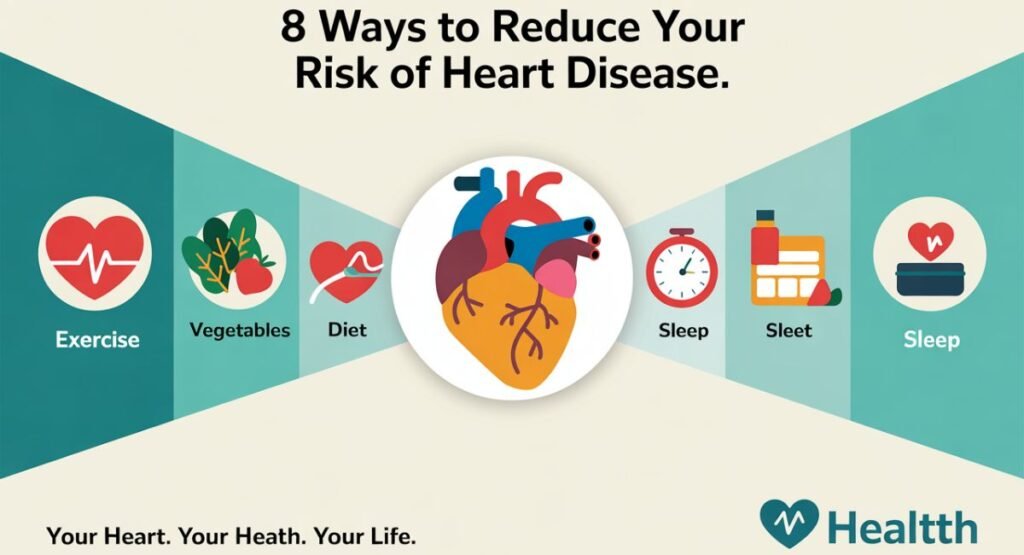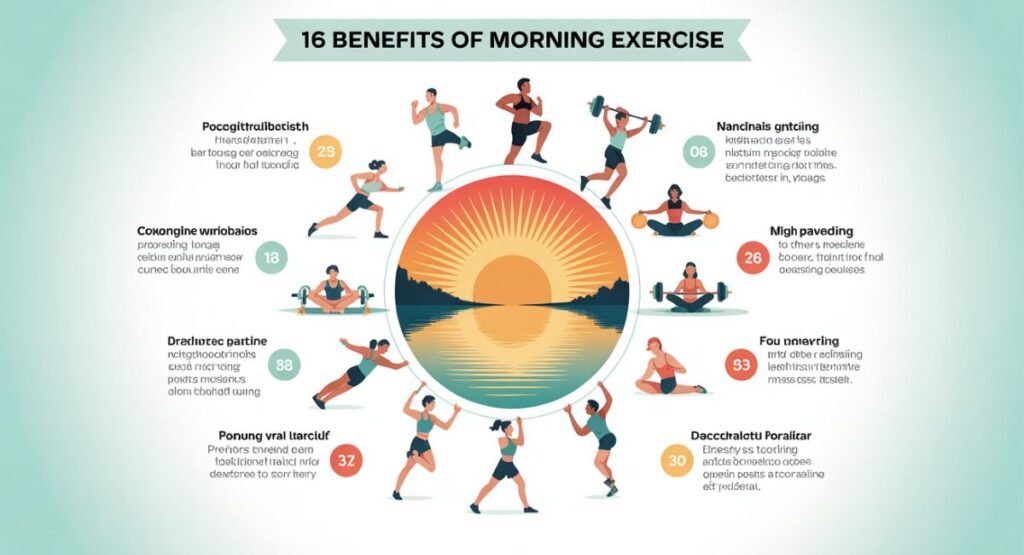Table of Contents
Introduction
Maintaining general heart health isn’t complicated when you understand the root causes and make steady, meaningful changes. Across the United States, cardiovascular disease remains the leading cause of death, yet many cases are preventable. Through practical heart health strategies, you can build healthy heart habits that protect your future.
Small daily actions shape long-term wellness. By embracing proven heart care tips and evidence-backed heart disease prevention tips, you give your heart the resilience it needs. This guide reveals eight effective methods for heart attack prevention while unpacking essential information on risks, warning signs, and long-term heart protection.
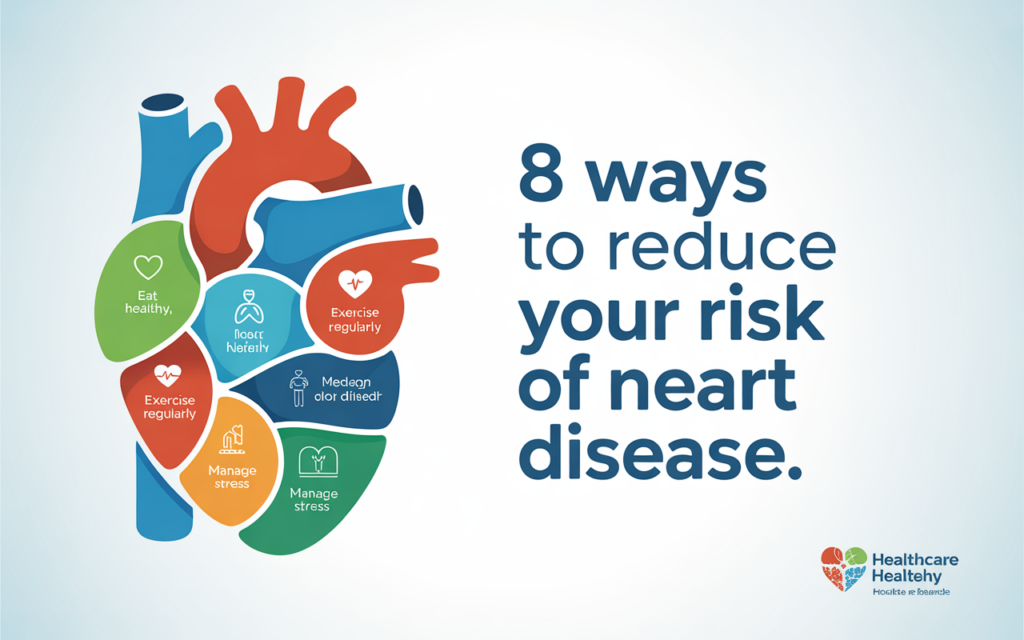
Understanding Heart Disease
Understanding coronary artery disease and other forms of cardiovascular disease is the first step toward meaningful prevention. These conditions usually develop silently through plaque buildup in arteries, which slowly restricts blood flow. Over time, unchecked cholesterol levels and blood pressure control problems can lead to life-threatening sudden cardiac events.
Heart disease develops in stages, often without dramatic symptoms until damage is extensive. Early attention to general heart health gives you the best chance to intervene before complications arise. Knowledge empowers smart decisions that strengthen cardiovascular health.
What is heart disease?
Heart disease refers to a range of disorders affecting how the heart and blood vessels work. The most common type is coronary artery disease, which involves plaque buildup in arteries that deliver oxygen-rich blood to the heart. As the arteries narrow, blood flow blockage increases the risk of a heart attack.
Common types and how they affect your body
Different forms impact your body in unique ways. Atherosclerosis and plaque buildup can trigger chest discomfort and limit physical endurance. Heart rhythm disorders disturb normal beating patterns, while high blood pressure (hypertension) strains vessels and forces the heart to work harder. Over time, these disruptions reduce improvements in heart function.
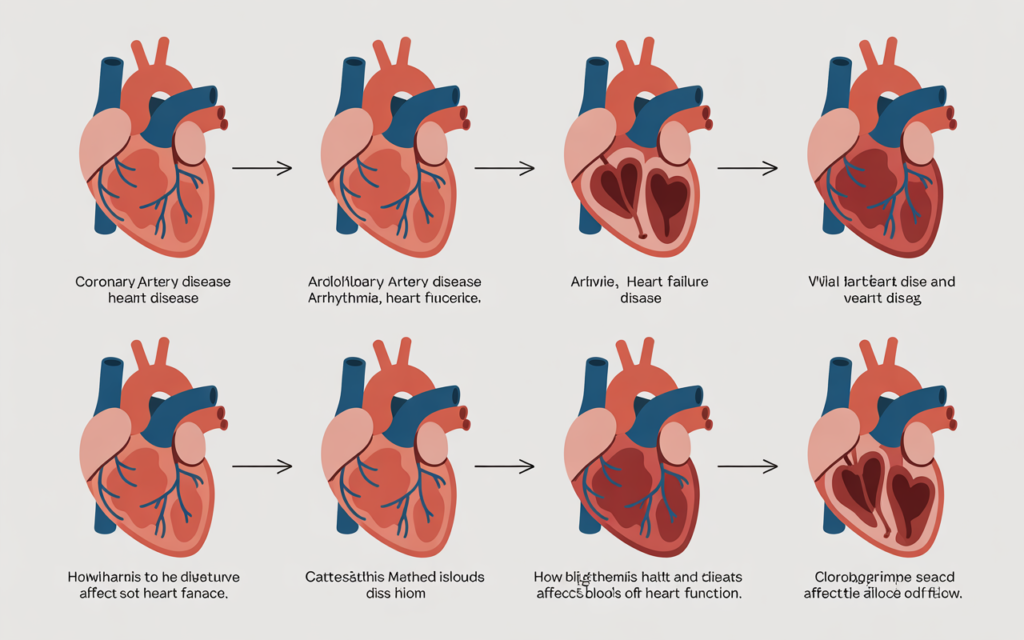
Why heart disease is a serious global concern
Heart disease accounts for millions of deaths each year. In the U.S. alone, one person dies every 33 seconds from cardiovascular disease, making it the leading cause of death. Globally, these conditions affect both rich and developing nations, highlighting the urgency for accessible heart health strategies and education.
Major Causes and Risk Factors
Many risk factors & causes for heart attack prevention can be controlled with targeted action. Some risks are external, like smoking or poor diet, while others stem from genetic predisposition. Both categories influence how quickly plaque buildup in arteries occurs and how resilient your cardiovascular system remains.
Early awareness makes prevention easier. Lifestyle habits often act silently, increasing your vulnerability over time. Obesity and heart disease, high LDL cholesterol, and low HDL cholesterol are key drivers. Monitoring your blood sugar and managing diabetes and cardiovascular risk are equally crucial for sustaining heart-healthy lifestyle changes.
Lifestyle-related risks (smoking, diet, inactivity)
Regular tobacco use accelerates atherosclerosis, while diets rich in saturated fats, sugars, and sodium damage vascular linings. A sedentary lifestyle reduces circulation efficiency, weakens heart muscle, and increases high blood pressure (hypertension) risk. Over time, these factors combine to create dangerous blood flow blockages.
Genetic and medical risk factors
Your genes influence how your body handles cholesterol levels and blood pressure control. A family history of coronary artery disease, genetic predisposition, and conditions like diabetes and cardiovascular risk make vigilance essential. Regular healthcare provider consultation and preventive health checkups provide early detection and intervention opportunities.
Silent risks you might not notice early
Some risks develop quietly. Low HDL cholesterol, mild high LDL cholesterol, or slightly elevated blood pressure often show no symptoms initially. Insulin resistance, subtle atherosclerosis and plaque buildup, and mild inflammation can quietly progress. By the time symptoms of a heart attack appear, significant damage may already exist.
Who Is Most at Risk?
Knowing who faces the greatest risks sharpens prevention efforts. Certain groups experience elevated vulnerability due to age, genetic predisposition, or medical background. Identifying your risk category encourages proactive steps like regular health screenings and structured heart care tips.
Societal factors also play a role. Many Americans underestimate sedentary lifestyle risks and delayed blood sugar monitoring, increasing their exposure. By understanding demographic patterns, people can adapt heart health strategies tailored to their unique profile.
Age and gender differences
Men typically face higher cardiovascular disease risks earlier in life, while women’s risk escalates post-menopause. Age compounds other factors—arterial elasticity declines, and plaque buildup in arteries accelerates. Older adults benefit most from lifestyle changes to prevent heart disease and consistent medical checkups for heart health.
Family history and pre-existing conditions
A strong family record of coronary artery disease raises your likelihood of developing it too. Conditions like diabetes and cardiovascular risk, high blood pressure (hypertension), or high LDL cholesterol further amplify risk. Regular preventive health checkups enable timely medication management for heart health.
Key warning signs to monitor
Pay close attention to early warning signs of heart attack. Chest pain warning signs, pressure in the chest, shortness of breath during a heart attack, or unusual fatigue are critical alerts. Discomfort in the jaw and arms may signal an impending sudden cardiac event, demanding quick medical intervention.
1. Quit Smoking and Avoid Tobacco
Quitting smoking is one of the fastest ways to reduce the risk of heart disease. Cigarette toxins injure arterial walls, foster plaque buildup in arteries, and encourage blood flow blockage. Over time, these effects increase cardiovascular disease risks dramatically. Embracing stop-smoking programs provides tangible quit-smoking benefits almost immediately.
The body begins healing as soon as you stop. Within weeks, circulation improves and cholesterol levels stabilize. Lung and heart functions strengthen gradually, lowering sudden cardiac event chances. Incorporating heart health strategies like counseling and healthcare provider consultation improves success rates.
How smoking damages your heart
Nicotine and carbon monoxide disrupt oxygen delivery, inflame arterial linings, and accelerate atherosclerosis and plaque buildup. These changes increase blood pressure, force the heart to pump harder, and strain cardiovascular health. Over time, smoking becomes one of the most powerful drivers of coronary artery disease.
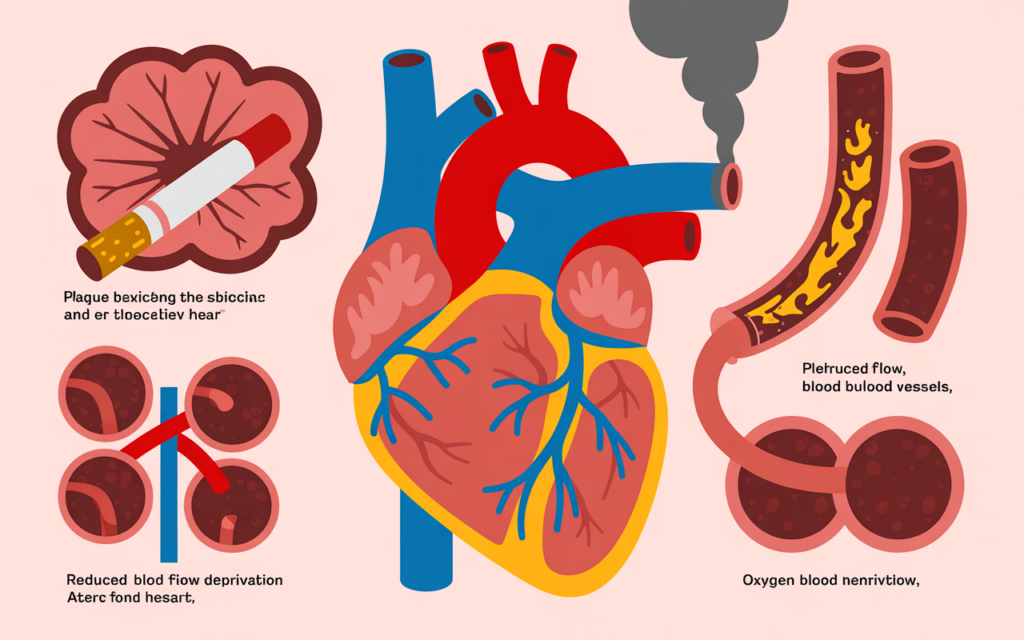
Tips and tools to help you quit effectively
Structured stop-smoking programs, nicotine replacement, support groups, and personalized coaching offer higher success. Many people benefit from combining behavioral changes with medical aids. Consistency and strong motivation deliver sustainable quit-smoking benefits for long-term heart protection.
2. Eat a Heart-Healthy Diet
A healthy diet for the heart is foundational for heart attack prevention. Nutrient-rich meals stabilize cholesterol levels, maintain blood pressure control, and reduce inflammation. Prioritizing heart-healthy foods (omega-3, fiber, and vegetables) ensures arteries remain flexible and resistant to plaque buildup in arteries.
Nourishing your body with the right balance fuels improving heart function and sustains cardiovascular health over decades. The American Heart Association emphasizes eating patterns focused on variety, moderation, and nutrient density as effective heart health strategies.
Foods to prioritize (fiber, healthy fats, antioxidants)
Plant-based meals rich in soluble fiber lower high LDL cholesterol and raise low HDL cholesterol. Fatty fish, nuts, and seeds offer omega-3s that protect against blood flow blockage. Antioxidant-rich vegetables reduce oxidative stress, supporting heart-healthy lifestyle practices.
Foods to limit (saturated fats, sugars, sodium)
High intake of saturated fats, added sugars, and sodium accelerates plaque buildup in arteries. Processed snacks, sugary drinks, and fast food worsen obesity and heart disease. Adopting a low-saturated-fat diet helps keep cholesterol levels balanced and arteries clear, promoting long-term heart protection.
3. Stay Physically Active
Staying active is one of the most powerful heart health strategies you can adopt. Regular movement boosts circulation, strengthens your heart muscle, and supports healthy cholesterol levels. Meeting basic physical activity guidelines helps lower blood pressure, improve weight balance, and reduce the likelihood of cardiovascular disease.
Even modest activity produces remarkable benefits. Regular exercise benefits include improved vascular flexibility, better oxygen use, and lower blood flow blockage risks. For those who lead sedentary lifestyles, beginning with light activity can drastically improve general heart health within weeks.

Ideal types of exercise for heart health
The goal is at least 30 minutes of aerobic exercise most days of the week. Brisk walking, cycling, swimming, or dancing enhance cardiovascular health. Moderate resistance training twice weekly strengthens supporting muscles, reduces obesity and heart disease risk, and aids in long-term heart attack prevention.
Safe ways to start if you’re new to activity
Start slowly, especially if you’ve been inactive for a while. Begin with short walks, gradually increasing duration and intensity. Always consult a healthcare provider before starting a new program if you have coronary artery disease or other conditions. Consistency matters more than intensity when building sustainable heart-healthy lifestyle habits.
4. Know Your Numbers: Cholesterol, Blood Pressure & Sugar
Knowing your health numbers is essential for early warning signs of heart attack prevention. Blood pressure control, cholesterol levels, and blood sugar influence plaque buildup in arteries and atherosclerosis development. Regular monitoring helps detect subtle shifts before major problems occur.
These numbers act like a dashboard for cardiovascular health. When levels stay in healthy ranges, the heart works more efficiently, and the risk of blood flow blockage drops dramatically. Ignoring these values can silently increase sudden cardiac event likelihood.
Why these metrics matter
High LDL cholesterol, low HDL cholesterol, high blood pressure (hypertension), and elevated glucose create a damaging environment for arteries. These factors accelerate plaque buildup, impair improving heart function, and increase heart attack prevention challenges. Recognizing abnormal values early allows for medication management for heart health or lifestyle interventions.
How to monitor and manage them regularly
Routine preventive health checkups and blood sugar monitoring are crucial. Home blood pressure cuffs, regular lipid panels, and glucose tests track your progress. If needed, your healthcare provider consultation may include daily aspirin considerations, statins, or other therapies to support long-term heart protection.
5. Manage Weight, Stress & Sleep
Maintaining a healthy weight, controlling stress, and prioritizing sleep are powerful heart care tips. Excess body fat fuels obesity and heart disease, while chronic tension disrupts blood pressure control. Poor sleep weakens cardiovascular health, leaving your heart more vulnerable to coronary artery disease and plaque buildup.
Balanced daily routines support heart-healthy lifestyle improvements. Sustained lifestyle changes to prevent heart disease often start with small, manageable shifts like consistent bedtimes, healthier meals, or mindful breaks during the day. Over time, these habits strengthen general heart health.
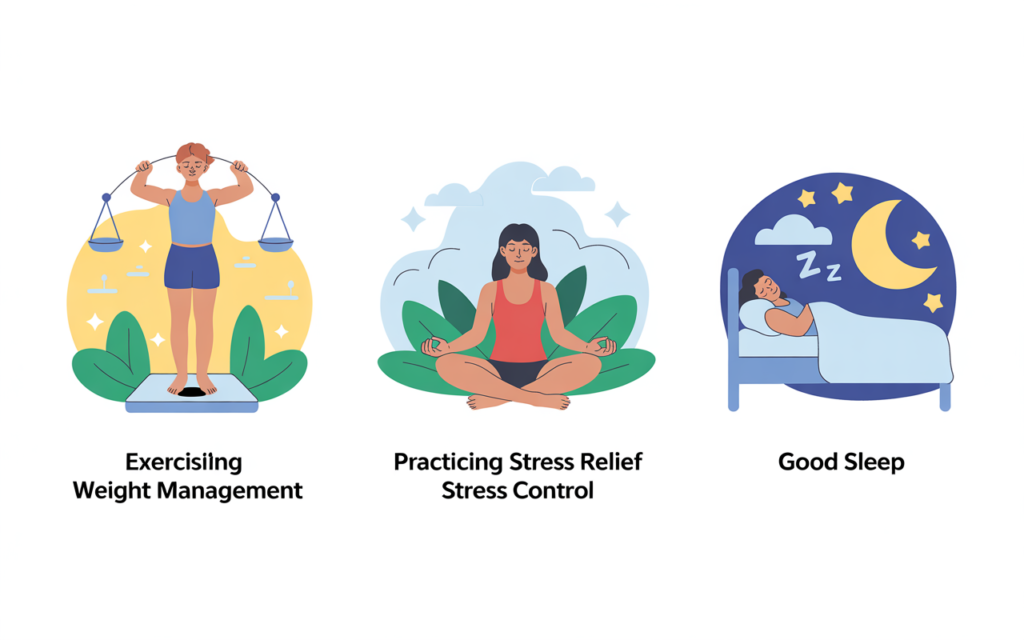
The impact of obesity on heart health
Excess fat increases high blood pressure, raises LDL cholesterol, and contributes to atherosclerosis and plaque buildup. Even moderate weight loss can enhance blood flow, lower stress on the heart, and improve cholesterol levels. Sustainable changes, not quick fixes, deliver lasting heart attack prevention benefits.
Chronic stress and its hidden dangers
Ongoing stress releases hormones that elevate blood pressure and increase inflammation. Over time, this harms cardiovascular health and accelerates plaque buildup in arteries. Effective stress reduction techniques like meditation, breathing exercises, or time in nature improve emotional balance and heart resilience.
Sleep quality as a prevention strategy
Good sleep allows the heart to recover. Chronic sleep deprivation raises high blood pressure, disrupts blood sugar, and increases sudden cardiac event risk. Aim for 7–9 hours nightly, maintain a dark, quiet sleep environment, and treat sleep as a core element of heart health strategies.

6. Medical Checkups and Preventive Steps
Consistent medical checkups for heart health catch silent issues early and guide heart attack prevention. Through preventive health checkups, doctors detect high LDL cholesterol, blood pressure control issues, or early atherosclerosis before symptoms arise. This allows time to act before coronary artery disease progresses.
Modern medicine offers numerous tools to maintain cardiovascular health. With personalized healthcare provider consultation, many individuals successfully manage conditions like diabetes and cardiovascular risk, preventing severe sudden cardiac events and improving long-term heart protection.
Regular screenings and why they’re vital
Routine exams reveal subtle problems such as low HDL cholesterol, mild high blood pressure, or irregular sugar levels. Early discovery through screenings supports targeted medication management for heart health, lifestyle shifts, or aspirin preventive therapy if appropriate.
Preventive options (like daily aspirin — if advised)
Some people benefit from daily aspirin therapy to lower clot risk. However, it must be guided by a healthcare provider consultation, as unnecessary use can lead to complications. When used correctly, aspirin can complement other heart health strategies to prevent blood flow blockage.
Managing diabetes for maximum heart protection
Controlling diabetes and cardiovascular risk significantly lowers coronary artery disease progression. Tight blood sugar monitoring, proper medication, and heart-healthy foods (omega-3, fiber, vegetables) reduce plaque buildup in arteries. Managing diabetes effectively is crucial for long-term heart protection.
Recognizing Early Symptoms of a Heart Attack
Recognizing symptoms of heart attack early saves lives. Warning signs often appear differently between men and women. Understanding chest pain warning signs, shortness of breath during heart attack, and discomfort in jaw and arms enables timely emergency heart attack response.
Quick action dramatically improves heart attack recovery and survival rates. Early recognition and immediate emergency care reduce damage and improve long-term cardiovascular health outcomes.
Classic vs. subtle symptoms in men and women
Men may experience crushing chest pain, while women often notice fatigue, nausea, or subtle discomfort. Both genders can develop shortness of breath during heart attack, pain radiating to the arms, jaw, or back. These early warning signs of heart attack should never be ignored.
When to seek emergency care immediately
Call emergency services at the first sign of chest pain, shortness of breath, or unexplained discomfort. Swift quick medical intervention minimizes heart muscle damage and improves heart attack recovery and survival rates. Waiting increases the risk of permanent damage or fatal sudden cardiac events.
Key Takeaways and Next Steps
Preventing cardiovascular disease requires consistent lifestyle changes to prevent heart disease rather than quick fixes. By applying these heart disease prevention tips daily, you can strengthen general heart health, lower risk factors, and enjoy lasting vitality. The eight strategies outlined build a solid foundation for long-term heart protection.
Staying motivated involves celebrating small wins. Each positive habit—whether it’s eating heart-healthy foods, committing to regular exercise benefits, or attending preventive health checkups—accumulates powerful effects. Over time, these choices transform into resilient heart-healthy lifestyle patterns that protect your well-being for years.
Small daily changes that make a big difference
Small shifts like quit smoking benefits, adopting a low saturated fat diet, or tracking cholesterol levels yield significant improvements. Gradual change is more sustainable and less overwhelming than sudden transformations. Each daily action contributes to improving heart function and lowering sudden cardiac event risk.
How to stay motivated for long-term heart health
Remind yourself why it matters. Track your progress, lean on supportive communities, and consult your healthcare provider regularly. Over time, these habits become second nature, anchoring a strong, heart-healthy lifestyle that sustains long-term heart protection.
📊 Sample Table: Healthy vs. Unhealthy Choices
| Category | Healthy Heart Choices | Unhealthy Heart Choices |
|---|---|---|
| Diet | Heart-healthy foods like vegetables, fiber, omega-3 | High sugar, sodium, and saturated fats |
| Physical Activity | 30 minutes of aerobic exercise daily | Sedentary lifestyle risks |
| Habits | Quit smoking benefits, stress reduction techniques | Smoking, chronic stress |
| Monitoring | Blood pressure control, regular health screenings | Ignoring early warning signs of heart attack |
Is vitamin C good for the heart?
Yes, vitamin C supports cardiovascular health by reducing inflammation, improving cholesterol levels, and protecting blood vessels from damage. Regular intake through fruits or supplements may lower the risk of heart disease.
How to diagnose heart disease in children?
Heart disease in children is usually diagnosed through physical exams, echocardiograms, electrocardiograms (ECG), and sometimes chest X-rays or MRI scans. Early detection helps doctors manage symptoms and prevent future complications effectively.
How to prevent a heart attack at home?
How to prevent a heart attack at home?
